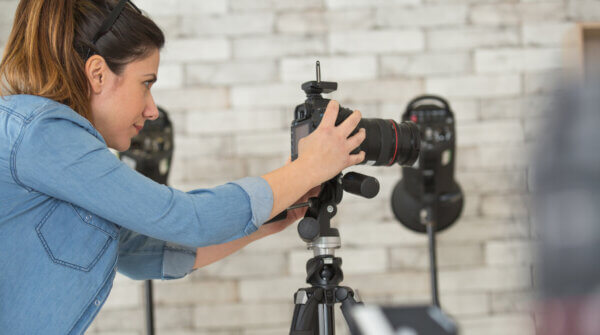January 26 2024
Tags:
Share:
Photography is usually an essential and intrinsic part of an organisation’s brand. Whether you’re using imagery for an impact report, website, or social posts, there needs to be a set style and personality that reinforces who you are, supports your brand and is used in a consistent way. But what if your organisation is in a tricky space or has a sensitive subject and photography is difficult to use? Do you avoid imagery altogether, or is there a way around using it in a creative and meaningful way?
The good news is the answer is yes you can.
We’ve worked with lots of organisations who don’t think that they can use photography as part of their brand. Sometimes it can be difficult to think of how you can use photography. Maybe there are subjects that don’t pair with real life imagery or photos of people; or maybe the topic just isn’t that interesting. Budget for commissioning photography might also be a barrier and stock imagery is the only option. That then might mean you’re concerned that you’ll look like everyone else or that the photos themselves might not be good enough for the subject.
Whilst that all sounds a bit negative, there are a number of different ways to incorporate a creative and robust imagery style into your brand guidelines that will let you be confident and positive with your messaging and add a whole new layer to your brand. Here are five things to consider when adding photography:
Focus on the positive
It’s often difficult to look past the problem that your organisation works to combat or address.
The National Migraine Centre didn’t want their imagery to show people in dark rooms, holding their heads in pain. Why would they? Instead we helped them find a more aspirational style. The strapline of their new brand was ‘Getting back to living’ so we developed photographic guidance in the brand guidelines to only use imagery of people enjoying life, positive, active everyday life and what people want to get back to experiencing. There are of course times when you absolutely need to show the issues and the problem, but when developing a set of guidelines it’s important to create an honest visual language that inspires, and provides a purpose led vision.
Don’t do dull
If you have a topic or subject that seems a bit dry or overly specific, this doesn’t mean you have find images to match! Dull images are not going to inspire your audience. An example of this is an NHS IT support department client. They had previously used images of network cables, laptops, mobile phones and connector sockets. They assumed people would need to see a laptop to think “oh, yeah, my laptop is running slow, I’ll call IT”. No one wants to see a bundle of cables, they are boring and possibly frightening at the best of times and those type of photos have usually been used many times before.
The way we approached this challenge was to align the IT team with the ultimate purpose of the NHS – helping deliver patient care, and that they were a team of knowledgeable experts providing the lifeblood of technology behind the scenes, to save lives. IT is complex. The infrastructure dense, but often invisible; and as long as it’s working no one even knows it’s there. Based on that we developed a photographic concept showing networks in nature – this emphasised both the complexity and hidden elements and highlighted a perspective not often seen. The concept was built around the statement: ‘A natural understanding of your technological needs’. Ultimately it created an expansive, interesting and vibrant imagery set that provided positivity.
Stuck with stock
Stock imagery can be another challenge. You may need to use it if you don’t have the budget to commission or access rights-managed imagery. Most organisations use image libraries for some if not all of their photographic content. Stock imagery can work extremely well and there are so many libraries out there now providing infinite options. But that infinite repository can be daunting if you don’t have criteria to guide you. There’s also the concern that lots of other people might be using the same image. However if you have a a defined concept and style as part of your brand guidelines, you can make it work. By having a style to follow, you can make images individual and make the selection process much easier. By using different crops; colour filters; shapes that house the images or pairing them with graphical brand devices are all ways to set them apart and create a consistent brand element.
Making sure images meet your sector’s/subject’s guidelines
Accuracy and compliance is always a concern when using images. Whether commissioned photography or stock photos, be sure to set guidelines and checks to comply with your environment. A reshoot or buying new imagery can be an expensive exercise. It goes without saying that model releases (permission from the model and defining how and where photos with models can be used) should be sought when using your own imagery; but but also think about selecting imagery that complies with your sector’s health and safety standards. As an example, the recent rebrand for Association for Science Educators needed imagery to show young people in science classroom settings. Checks and information about this appeared in the guidelines to make sure the imagery is both scientifically accurate and adheres to health and safety approaches such as ‘are they wearing appropriate safety goggles’. Stock imagery doesn’t always comply so don’t assume that this is covered.
It doesn’t have to be a photo
Sometimes it may be too difficult to use photography, so this is when illustration could be used instead. Whether you’re commissioning an illustrator, or selecting stock illustration, you still need to set guidance to make sure brand personality is consistent and reinforces your values. You can set criteria that sets the style, such as bold and vibrant, linear or sketchy, rustic or childlike. We recently worked with the Eve Appeal on a set of resources for helping employers engage and educate their employees on the signs of gynaecological cancers. We worked with an illustrator to create a set of diverse and approachable designs to support the materials.
If photography is an area you’ve struggled to incorporate successfully don’t just exclude it. There is always a creative way to include it as an important asset. Equally, don’t just add photography into your brand guidelines unless it’s unique to your organisation and enhances and adds an interesting layer to the brand experience. By developing a photography brief and setting a small checklist in the guidelines will help your team make good searches and selections. They will enjoy the process and be thankful for that guidance. Photography adds real life into a brand and with charities it’s an asset that provides huge storytelling opportunity and connection.
If you want to consider photography in your brand refresh or develop a new set of consistent imagery and can’t think of a creative direction, get in touch with us for a conversation.




